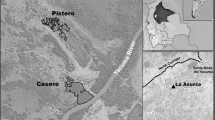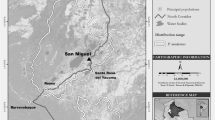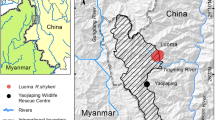Abstract
Rapid global deforestation has forced many of the world’s primates to live in fragmented habitats, making the understanding of their behavioral responses to degraded and fragmented habitats a key challenge for their future protection and management. The black-and-white snub-nosed monkey (Rhinopithecus bieti) is an endangered species endemic to southwest China. The forest habitat ranges from near-continuous to fragmented. In this study, we investigated the activity budget and diet of a R. bieti population that live in an isolated and degraded habitat patch at Mt. Lasha in Yunnan Province, near the current southern limit of the species. We used our data along with data from six other sites in more-continuous habitats across its range to model factors that predict stress, including feeding effort and time feeding on lichens against potential predictive parameters. Models showed feeding effort across all sites increased with increasing altitude and latitude, and with decreasing food species diversity. There was also a strong positive relationship between feeding effort and time feeding lichens. The Mt. Lasha R. bieti population exploited a total of 36 food species, spending 80.2% of feeding time feeding on lichens, Bryoria spp. and Usnea longissima. These figures are more comparable to those living in the north than those living in the mid- and southern part of the species’ range. Given the models for feeding effort and time feeding on lichens, the unexpectedly high time spend feeding on lichens and feeding effort relative to latitude and elevation are suggestive of a stressed population at Mt. Lasha.


Similar content being viewed by others
References
Agetsuma N, Nakagawa N (1998) Effects of habitat differences on feeding behaviors of Japanese monkeys: comparison between Yakushima and Kinkazan. Primates 39:275–289
Altmann J (1974) Observational study of behavior: sampling methods. Behaviour 49:227–267
Arroyo Rodríguez V, Mandujano S (2006) Forest fragmentation modifies habitat quality for Alouatta palliata. Int J Primatol 27:1079–1096
Asensio N, Cristobal-Azkarate J, Dias PA, Vea JJ, Rodríguez-Luna E (2007) Foraging habits of Alouatta palliata mexicana in three forest fragments. Folia Primatol 78:141–153
Balestri M, Barresi M, Campera M, Serra V, Ramanamanjato JB et al (2014) Habitat degradation and seasonality affect physiological stress levels of Eulemur collaris in littoral forest fragments. PLoS ONE 9:e107698
Burnham KP, Anderson DR (2002) Information and likelihood theory: a basis for model selection and inference In: Model selection and multimodel inference, Springer, pp 49–97
Cavigelli SA (1999) Behavioural patterns associated with faecal cortisol levels in free-ranging female ring-tailed lemurs, Lemur catta. Anim Behav 57:935–944
Cowlishaw G (1999) Predicting the pattern of decline of african primate diversity: an extinction debt from historical deforestation. Conserv Biol 13:1183–1193
Cowlishaw G, Dunbar RI (2000) Primate conservation biology. University of Chicago Press, Chicago
Dailey R, Montgomery D, Ingram J, Siemion R, Vasquez M, Raisbeck M (2008) Toxicity of the lichen secondary metabolite (+)-usnic acid in domestic sheep. Vet Pathol Online 45:19–25
Ding W, Zhao Q-K (2004) Rhinopithecus bieti at Tacheng, Yunnan: diet and daytime activities. Int J Primatol 25:583–598
Dunham NT (2011) Coping with forest fragmentation: a comparison of Colobus angolensis palliatus dietary diversity and behavioral plasticity in the East Sagara Forest, Tanzania. Honors project: Paper 36
Dunn JC, Cristóbal-Azkarate J, Schulte-Herbrüggen B, Chavira R, Veà JJ (2013) Travel time predicts fecal glucocorticoid levels in free-ranging howlers (Alouatta palliata). Int J Primatol 34:246–259
Dunn JC, Cristóbal-Azkarate J, Veà JJ (2010) Seasonal variations in the diet and feeding effort of two groups of howlers in different sized forest fragments. Int J Primatol 31:887–903
Estrada A, Garber PA, Rylands AB, Roos C, Fernandez-Duque E et al (2017) Impending extinction crisis of the world’s primates: why primates matter. Sci Adv 3:e1600946
Fontanillas P, Petit E, Perrin N (2004) Estimating sex-specific dispersal rates with autosomal markers in hierarchically structured populations. Evolution 58:886–894
Grueter CC, Li DY, Ren BP, Li M (2013) Overwintering strategy of Yunnan snub-nosed monkeys: adjustments in activity scheduling and foraging patterns. Primates 54:125–135
Grueter CC, Li DY, Ren BP, Wei FW, Xiang ZF, van Schaik CP (2009) Fallback foods of temperate-living primates: a case study on snub-nosed monkeys. Am J Phys Anthropol 140:700–715
Grueter CC, Li DY, van Schaik CP, Ren BP, Long YC, Wei FW (2008) Ranging of Rhinopithecus bieti in the Samage Forest, China. I. Characteristics of range use. Int J Primatol 29:1121–1145
Huang ZP, Cui LW, Scott MB, Wang SJ, Xiao W (2012) Seasonality of reproduction of wild black-and-white snub-nosed monkeys (Rhinopithecus bieti) at Mt. Lasha, Yunnan, China. Primates 53:237–245
Huo S (2005) Diet and habitat use of Rhinopithecus bieti at Mt. Longma, Yunnan. Ph.D Dissertation thesis, Kunming Institute of Zoology, CAS, Kunming
IUCN (2010) Red list of threatened species. www.iucnredlist.org
Jernvall J, Wright PC (1998) Diversity components of impending primate extinctions. Proc Natl Acad Sci 95:11279–11283
Kirkpatrick RC, Grueter CC (2010) Snub-nosed monkeys: multilevel societies across varied environments. Evolut Anthropol 19:98–113
Kirkpatrick RC, Long Y, Zhong T, Xiao L (1998) Social organization and range use in the Yunnan snub-nosed monkey Rhinopithecus bieti. Int J Primatol 19:13–51
Kirkpatrick RC (1996) Ecology and behavior of the Yunnan Snub-Nosed Langur Rhinopithecus bieti (Colobinae). PhD Dissertation thesis, University of California, Davis
Li BG, Pan RL, Oxnard CE (2002) Extinction of snub-nosed monkeys in China during the past 400 years. Int J Primatol 23:1227–1244
Liu ZH, Ding W, Grueter CC (2004) Seasonal variation in ranging patterns of Yunnan snub-nosed monkeys Rhinopithecus bieti at Mt. Fuhe, China (In Chinese abstract). Acta Zool Sin 50:691–696
Long Y, Kirkpatrick CR, Zhong T, Xiao L (1994) Report on the distribution, population, and ecology of the Yunnan snub-nosed monkey (Rhinopithecus bieti). Primates 35:241–250
MacArthur RH, Pianka ER (1966) On optimal use of a patchy environment. Am Nat 100:603–609
Marante FT, Castellano AG, Rosas FE, Aguiar JQ, Barrera JB (2003) Identification and quantitation of allelochemicals from the lichen Lethariella canariensis: phytotoxicity and antioxidative activity. J Chem Ecol 29:2049–2071
Marshall AJ, Boyko CM, Feilen KL, Boyko RH, Leighton M (2009) Defining fallback foods and assessing their importance in primate ecology and evolution. Am J Phys Anthropol 140:603–614
Marshall AJ, Wrangham RW (2007) Evolutionary consequences of fallback foods. Int J Primatol 28:1219–1235
Mittermeier RA, Cheney DL (1987) Conservation of primates and their habitats. In: Smuts BB, Cheney DL, Seyfarth RM, Wrangham RW, Struhsaker TT (eds) Primate societies. University of Chicago Press, Chicago, pp 477–490
Perry NB, Benn MH, Brennan NJ, Burgess EJ, Ellis G et al (1999) Antimicrobial, antiviral and cytotoxic activity of New Zealand lichens. Lichenologist 31:627–636
Pride RE (2005) High faecal glucocorticoid levels predict mortality in ring-tailed lemurs (Lemur catta). Biol Lett 1:60–63
R Core Team (2016) R: a language and environment for statistical computing. R foundation for statistical computing, Vienna, Austria. https://www.R-project.org/
Ratsimbazafy J, Ramarosandratana H, Zaonarivelo R (2002) How bo black-and-white ruffed lemurs still survive in a highly disturbed habitat? Lemur News 7:7–10
Sapolsky RM (1986) Endocrine and behavioral correlates of drought in wild olive baboons (Papio anubis). Am J Primatol 11:217–227
Stumpf RM (2011) Chimpanzees and bonobos: inter-and-intra species diversity. In: Campbell CJ, Fuentes A, MacKinnon KC, Bearder S, Stumpf RM (eds) Primates in perspective, 2nd edn. Oxford University Press, Oxford, pp 122–139
Tsuji Y, Hanya G, Grueter CC (2013) Feeding strategies of primates in temperate and alpine forests: comparison of Asian macaques and colobines. Primates 54:201–215
Wang LS, Narui T, Harada H, Culberson CF, Culberson WL (2001) Ethnic uses of lichens in Yunnan, China. The Bryologist 104:345–349
Wright PC (2007) Considering climate change effects in lemur ecology and conservation. In: Lemurs, Springer, pp. 385–401
Xiang ZF, Huo S, Xiao W (2010) Activity budget of Rhinopithecus bieti at Tibet: effects of day length, temperature and food availability. Curr Zool 56:650–659
Xiang ZF, Huo S, Xiao W, Quan RC, Grueter CC (2007) Diet and feeding behavior of Rhinopithecus bieti at Xiaochangdu, Tibet: adaptations to a marginal environment. Am J Primatol 69:1141–1158
Xiang ZF, Xiao W, Huo S, Li M (2013) Ranging pattern and population composition of Rhinopithecus bieti at Xiaochangdu, Tibet: implications for conservation. Sci Bull 58:2212–2219
Xiao W, Ding W, Cui LW, Zhou RL, Zhao QK (2003) Habitat degradation of Rhinopithecus bieti in Yunnan, China. Int J Primatol 24:389–398
Zhang LZ, He YC, Huang ZP (2012) Evaluation of primary food nutrition of Rhinopithecus bieti at Mt. Longma (In Chinese abstract). J Southwest For Univ 32:81–85
Acknowledgements
This study was supported by National Natural Science Foundation of China (31560118, 31260149, 31160422, and 31260159), Collaborative Innovation Center for Biodiversity and Conservation in the Three Parallel Rivers Region of China, Committee for Research and Exploration, National Geographic Society (Grant #7962-05), TNC “Conservation Ecology of Yunnan Snub-nosed Monkey (Rhinopithecus bieti) at Two Geographic Extremes of Species Range”, and the PhD Foundation from Dali University (KYBS201509), and Program for Backup Talents of Young Academic and Technical Leaders in Yunnan Province (2015HB047). We would be unable to accomplish this research without the help of our assistants and forest guards Zhang Jin-fu. We thank the Yunling Nature Reserve for permitting us to work there, and kindly offering necessary help during our study. Great thanks to Prof. Michael A. Huffman and an anonymous reviewer for useful suggestions that improved the manuscript.
Author information
Authors and Affiliations
Corresponding authors
About this article
Cite this article
Huang, ZP., Scott, M.B., Li, YP. et al. Black-and-white snub-nosed monkey (Rhinopithecus bieti) feeding behavior in a degraded forest fragment: clues to a stressed population. Primates 58, 517–524 (2017). https://doi.org/10.1007/s10329-017-0618-7
Received:
Accepted:
Published:
Issue Date:
DOI: https://doi.org/10.1007/s10329-017-0618-7




